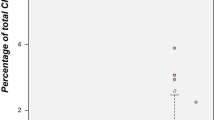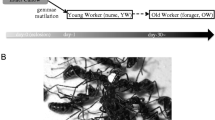Abstract
In cooperative societies such as those of ants, honey bees, and termites, the number of reproductives is often regulated by social interactions. In many termite species, helper individuals (i.e., larvae or workers) can potentially differentiate into a “neotenic” reproductive caste in the absence of reproductives. In some termite species, multiple neotenics coexist within a nest, often with female-biased sex ratios. However, although the presence of female neotenics can suppress neotenic differentiation of female workers, it is largely unknown how male neotenics affect the differentiation of female neotenics. Here, we show that male and female neotenics regulate the neotenic differentiation in a sex-specific manner in the damp-wood termite Hodotermopsis sjostedti, whose colonies are often headed by multiple male and female neotenics in the field. Our rearing experiments showed that the presence of female neotenics suppressed differentiation of female neotenics from fourth- to seventh-larvae, i.e., pseudergates (called as “workers” in this study), whereas male neotenics promoted the differentiation of female neotenics. Moreover, the results of rearing experiments that restricted physical contact between neotenics and workers suggested that these effects were not mediated by volatile chemicals, but rather by direct contact. We found that the male neotenics were frequently groomed by female workers, suggesting that these interactions promote the differentiation of female neotenics. Our results represent an empirical evidence that the neotenic differentiation from female and male workers is regulated by direct physical contact with the preexisting neotenics.




Similar content being viewed by others
References
Bignell DE, Roisin Y, Lo N (2011) Biology of termites: a modern synthesis. Springer, Dordrecht, p 576
Bourke AFG, Franks NR (1995) Social evolution in ants. Princeton University Press, Princeton, p 550
Cant MA (2012) Cooperative breeding systems. In: Royle NJ, Smiseth RT, Kölliker M (eds) The evolution of parental care. Oxford University Press, Oxford, pp 206–225
Dietemann V, Liebig J, Hölldobler B, Peeters C (2005) Changes in the cuticular hydrocarbons of incipient reproductives correlate with triggering of worker policing in the bulldog ant Myrmecia gulosa. Behav Ecol Sociobiol 58:486–496
Endler A, Liebig J, Schmitt T, Parker JE, Jones GR, Schreier P, Hölldobler B (2004) Surface hydrocarbons of queen eggs regulate worker reproduction in a social insect. Proc Natl Acad Sci USA 101:2945–2950
Gobin B, Billen J, Peeters C (1999) Policing behaviour towards virgin egg layers in a polygynous ponerine ant. Anim Behav 58:1117–1122
Hanus R, Vrkoslav V, Hrdý I, Cvačka J, Šobotník J (2010) Beyond cuticular hydrocarbons: evidence of proteinaceous secretion specific to termite kings and queens. Proc R Soc B 277:995–1002
Hoffmann K, Gowin J, Hartfelder K, Korb J (2014) The scent of royalty: a P450 gene signals reproductive status in a social insect. Mol Biol Evol 31:2689–2696
Hirono Y, Blass B (1990) Histological and ecological studies on the caste differentiation of the Japanese damp-wood termite Hodotermopsis japonica (Termopsidae: Isoptera). Univ Tokyo, Tokyo Doctor’s thesis
Howard RW, Haverty M (1980) Reproductives in mature colonies of Reticulitermes flavipes: abundance, sex-ratio, and association with soldiers. Environ Entomol 9:458–460
Howard RW, Jones SC, Mauldin JK, Beal RH (1982) Abundance, distribution, and colony size estimates for Reticulitermes spp. (Isoptera: Rhinotermitidae) in southern Mississippi. Environ Entomol 11:1290–1293
Kitade O, Hayashi Y, Takatsuto K, Matsumoto T (2012) Variation and diversity of symbiotic protist composition in the damp-wood termite Hodotermopsis sjoestedti. Jpn J Protozool 45:29–36
Kocher SD, Grozinger CM (2011) Cooperation, conflict, and evolution of queen pheromones. J Chem Ecol 37:1263–1275
Korb J (2015) Juvenile hormone: a central regulator of termite caste polyphenism. In: Zayed A, Kent CF (eds) Advances in insect physiology. Elsevier, Oxford, pp 131–161
Korb J, Hartfelder K (2008) Life history and development a framework for understanding developmental plasticity in lower termites. Biol Rev 83:295–313
Le Conte Y, Hefetz A (2008) Primer pheromones in social Hymenoptera. Annu Rev Entomol 53:523–542
Legendre F, Whiting MF, Grandcolas P (2013) Phylogenetic analyses of termite post-embryonic sequences illuminate caste and developmental pathway evolution. Evol Dev 15:146–157
Lenz M (1985) Is inter- and intraspecific variability of lower termite neotenic numbers due to adaptive thresholds for neotenic eliminations?—considerations from studies on Porotermes adamsoni (Froggatt). In: Watson JAL, Okot-Kotber BM, Noirot C (eds) Caste differentiation in social insects. Oxford Pergamon Press, New York, pp 107–124
Lenz M, Barrett RA (1982) Neotenic formation in field colonies of Coptotermes lacteus (Froggatt) in Australia, with comments on the roles of neotenics in the genus Coptotermes (Isoptera: Rhinotermitidae). Sociobiology 7:47–59
Liebig J, Peeters C, Oldham NJ, Markstädter C, Hölldobler B (2000) Are variations in cuticular hydrocarbons of queens and workers a reliable signal of fertility in the ant Harpegnathos saltator? Proc Natl Acad Sci USA 97:4124–4131
Liebig J, Eliyahu D, Brent CS (2009) Cuticular hydrocarbon profiles indicate reproductive status in the termite Zootermopsis nevadensis. Behav Ecol Sociobiol 63:1799–1807
Lüscher M (1961) Social control of polymorphism in termites. In: Kennedy JS (ed) Insect polymorphism. Royal Entomological Society of London, London, pp 57–67
Maekawa K, Nakamura S, Watanabe D (2012) Termite soldier differentiation in incipient colonies is related to the parental proctodeal trophallactic behavior. Zool Sci 29:213–217
Matsumoto T, Hirono Y (1985) On the caste composition of a primitive termite Hodotermopsis japonicus Holmgren (Isoptera, Termopsidae). Sci Pap Coll Arts Sci 35:211–216
Matsuura K, Himuro C, Yokoi T, Yamamoto Y, Vargo EL, Keller L (2010) Identification of a pheromone regulating caste differentiation in termites. Proc Natl Acad Sci USA 107:12963–12968
Maynard Smith J, Szathmáry E (1995) The major transitions in evolution. Oxford University Press, Oxford, p 360
Miura T (2004) Proximate mechanisms and evolution of caste polyphenism social insects: from sociality to genes. Ecol Res 19:141–148
Miura T, Scharf ME (2011) Molecular basis underlying caste differentiation in termites. In: Bignell DE, Roisin Y, Lo N (eds) Biology of termites: a modern synthesis. Springer, Heidelberg, pp 211–253
Miura T, Hirono Y, Machida M, Kitade O, Matsumoto T (2000) Caste developmental system of the Japanese damp-wood termite Hodotermopsis japonica (Isoptera: Termopsidae). Ecol Res 15:83–92
Nijhout HF, Wheeler DE (1982) Juvenile hormone and the physiological basis of insect polymorphisms. Q Rev Biol 57:109–134
Oguchi K, Shimoji H, Hayashi Y, Miura T (2016) Reproductive organ development along the caste differentiation pathways in the dampwood termite Hodotermopsis sjostedti. Insect Soc. doi:10.1007/s00040-016-0495-x In press
R Core team (2014) A language and environment for statistical computing. R foundation for statistical computing, Vienna
Ratnieks FLR, Foster KR, Wenseleers T (2006) Conflict resolution in insect societies. Annu Rev Entomol 51:581–608
Roisin Y, Korb J (2011) Social organisation and the status of workers in termites. In: Bignell DE, Roisin Y, Lo N (eds) Biology of termites: a modern synthesis. Springer, Heidelberg, pp 133–164
Roisin Y, Lenz M (2002) Origin of male-biased sex allocation in orphanedcolonies of the termite Coptotermes lacteus. Behav Ecol Sociobiol 51:472–479
Sevala VL, Bagnèresm AG, Kuenzli M, Blomquist G, Scal C (2000) Cuticular hydrocarbons of the dampwood termites, Zootermopsis nevadensis: caste differences and role of lipophorin in transport of hydrocarbons and hydrocarbon metabolites. J Chem Ecol 19:2563–2576
Thorne BL, Traniello JFA, Adams ES, Bulmer M (1999) Reproductive dynamics and colony structure of subterranean termites of the genus Reticulitermes (Isoptera Rhinotermitiae): a review of the evidence from behavioral, ecological, and genetic studies. Ethol Ecol Evol 11:149–169
Tsuji K, Egashira K, Hölldobler B (1999) Regulation of worker reproduction by direct physical contact in the ant Diacamma sp. from Japan. Anim Behav 58:337–343
Weil T, Hoffmann K, Kroiss J, Strohm E, Korb J (2009) Scent of a queen—cuticular hydrocarbons specific for female reproductives in lower termites. Sci Nat 96:315–319
Wenseleers T, Ratnieks FLW (2004) Tragedy of the commons in Melipona bees. Biol Lett 271:310–312
Wilson EO (1971) The insect societies. Belknap Press of Harvard University Press, Cambridge, p 562
Yaguchi H, Inoue T, Sasaki K, Maekawa K (2016) Dopamine regulates termite soldier differentiation through trophallactic behaviours. R Soc Open Sci 3:150574. doi:10.1098/rsos.150574
Acknowledgements
We thank Osamu Kitade in Ibaraki University for valuable discussions and sharing his field data; Masahiro Shimizu for assistance with the experimental setup; and Dai Watanabe, Yasuhiro Sugime, and Run Minoura for collecting termites and maintenance of stock colonies. This work was supported by a Grant-in-Aid from the Japan Society for the Promotion of Science Fellows (no. 13J04279 to HS) and a Grant-in-Aid for Scientific Research A (no. 25251041 to TM) from the Ministry of Education, Culture, Sports, Science and Technology of Japan.
Author information
Authors and Affiliations
Corresponding author
Additional information
Hiroyuki Shimoji, Kohei Oguchi and Yoshinobu Hayashi contributed equally to this research.
Electronic supplementary material
Below is the link to the electronic supplementary material.
Rights and permissions
About this article
Cite this article
Shimoji, H., Oguchi, K., Hayashi, Y. et al. Regulation of neotenic differentiation through direct physical contact in the damp-wood termite Hodotermopsis sjostedti . Insect. Soc. 64, 393–401 (2017). https://doi.org/10.1007/s00040-017-0562-y
Received:
Revised:
Accepted:
Published:
Issue Date:
DOI: https://doi.org/10.1007/s00040-017-0562-y




